Timetable › Forums › Standard › Trigonometry › Bearings – Non Right
Tagged: Bearings, Non-Right Trig
-
AuthorPosts
-
Bearings Non-Right Trig
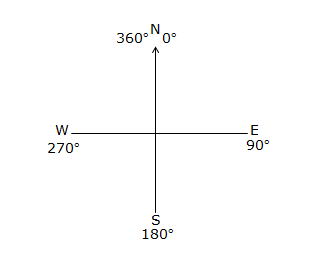
Sine Rule
$$\frac{a}{\sin\; A}=\frac{b}{\sin\; B}$$
$$\frac{\sin\; A}{a}=\frac{\sin\; B}{b}$$Cos Rule
$$a^2=b^2+c^2-2bccos A$$
$$cos\;A=\frac{b^2+c^2-a^2}{2bc}$$Area Rule
$$A=\frac{1}{2}ab\sin\;C$$
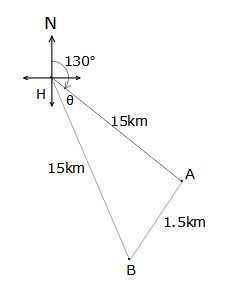 Sue leaves home and walks 15km on a bearing of 130°, arriving at point A. Jessica, her sister leaves home a little after Sue and also walks 15km but due to a compass error, arrives too far south and not far enough east, arriving a part B which is 1.5 km from point A. Which bearing did Jessica take?
Sue leaves home and walks 15km on a bearing of 130°, arriving at point A. Jessica, her sister leaves home a little after Sue and also walks 15km but due to a compass error, arrives too far south and not far enough east, arriving a part B which is 1.5 km from point A. Which bearing did Jessica take?$$\cos\theta=\frac{15^2+15^2-1.5^2}{2\times15\times15}$$
θ = 5.7º
∴ bearing = 130º + 5.7º
= 135.7°
A plane flies from Mascot Airport on a bearing of 050° at 500 knots. Another plane leaves Mascot Airport at the same time and flies on a bearing of 120° at 400 knots. (1 knot = 1 nautical mile per hour)
a. Copy and complete the information on a diagram.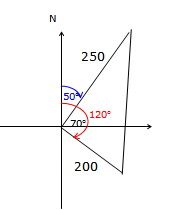 b. How far apart will the planes be after 30 minutes, correct to the nearest nautical mile?
b. How far apart will the planes be after 30 minutes, correct to the nearest nautical mile?a.
b. 30 minutes is half an hour, so the first distance ½ × 500 = 250 nautical miles
the second distance ½ × 400 = 200 nautical miles
the first bearing is 50° and the second bearing is 120°, leaving the angle in between them as 120° – 50° = 70°
since we have two sides and the included angle, will be using the cos rule
x2 = 2502 + 2002 – 2 × 250 × 200 × cos 70°
x2 = 68,297.99
x = 261 nautical miles
A ship sails 40 nautical miles from A to B on a course bearing of 060°, and then 25 nautical miles due east from B to C.
a. What is the distance from A to C?
b. What is the bearing of C from A?
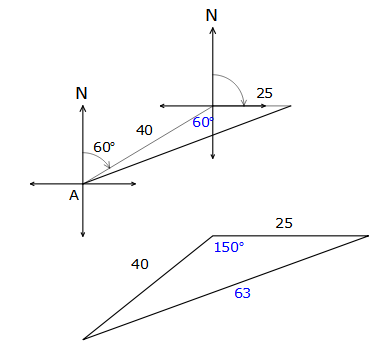
make a diagram, and label carefully
the ∠B consists of two parts, the 60°, which is an alternate ∠ in the parallel lines, and 90°, since C is due east of B 60° + 90° = 150°
a. AC2 = 402 + 252 – 2 × 40 × 25 × cos 150°
AC2 = 3957.05
AC = 63 nm
Use the cos rule to find the length of AC
b.$$\frac{\sin A}{25}=\frac{\sin 150}{63}$$
$$\sin A = 25\times\frac{\sin 150}{63}$$
use the sine rule to find ∠BAC
A = 11°
∴ 071°
now the bearing will be 60° + 11° (and don’t forget a true bearing has to have 3 digits)
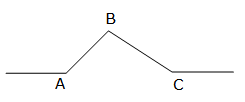 A mining surveyor is travelling due east in nearly flat. To avoid a flooded area, a detour is made by first driving from A to B, a distance of 15 km, on a bearing of 062°. From B she drives southeast until rejoining the original line of travel at C.
A mining surveyor is travelling due east in nearly flat. To avoid a flooded area, a detour is made by first driving from A to B, a distance of 15 km, on a bearing of 062°. From B she drives southeast until rejoining the original line of travel at C.
a. Copy the diagram. Find the sizes of ∠BAC and ∠ABC, marking them on the diagram.
b. Use the Sine Rule to calculate the distance AC, give your answer to the nearest tenth of a kilometre.a. ∠BAC = 90° – 62°, as it forms a right angle, since C is due east
∠BAC = 28°
since the 62 is alternate ∠ in the parallel lines, 180 – 45° = 135°, since on a straight line and south-east means a bearing of 135°∠ABC = 62° + 45°
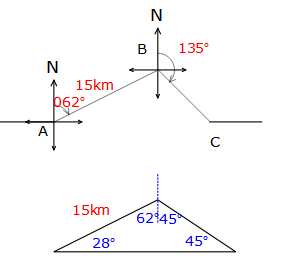
b. $$\frac{AC}{\sin 107^{\circ}}=\frac{15}{\sin 45^{\circ}}$$
$$AC=\frac{15\sin107^{\circ}}{\sin45^{\circ}}$$
AC = 20.3 km
Use the sine rule in the triangle with the angles found above to find the length of AC -
AuthorPosts
- You must be logged in to reply to this topic.



